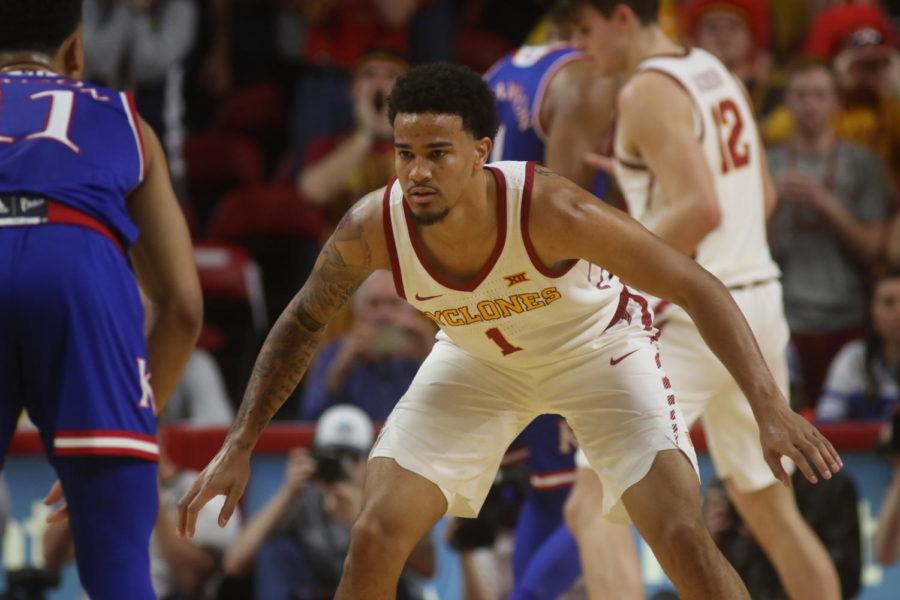Marner: Small-ball presents challenges for Cyclones
February 26, 2019
A lot has been made about Iowa State’s up and down season this year.
Coach Steve Prohm has said he has an ‘A’ and ‘B’ team. The ‘A’ team can beat anyone, anywhere, anytime.
The ‘B’ team? It lacks energy, doesn’t move the ball offensively and has defensive gaps all over the place.
The defensive issues Iowa State has had lately have shown just how troubling the ‘B’ team can be. That issue is only exacerbated by the reliance on playing small.
Prohm has said multiple times this season he wants to play small. The Cyclones have a handful of more-than-capable guards, from redshirt seniors Nick Weiler-Babb and Marial Shayok all the way to freshmen Tyrese Haliburton and Talen Horton-Tucker. Off the bench is sophomore guard Lindell Wigginton, the immensely talented scorer who averaged 16 points per game last year.
But playing small comes at a cost. Lately, that cost has been rebounding.
This year, opponents are grabbing 29.3 percent of their missed shots against Iowa State. The nation’s average is 28.5 percent. Iowa State is 228th nationally out of 353 teams in defensive rebounding percentage.
“We gave 12 offensive rebounds up,” Prohm said after a 78-61 win over Oklahoma on Monday. “That’s too many.
“When you look at it mathematically, we want to give up less than 25 percent of our misses … if they’re rebounding 40 percent of their misses, we’re in trouble.”
Prohm said that was the issue in the recent loss to Baylor, along with the December loss at in-state rival Iowa. Iowa rebounded a miraculous 60.7 percent of its misses, grabbing 17 offensive rebounds while the Cyclones mustered 11 defensive rebounds.
It’s not hard to see why the Cyclones are giving up too many boards.
Two teams — Texas Christian (TCU) and Baylor — have swept Iowa State this season. Those two teams play considerably different styles, but they have the same result — Iowa State ends up with mismatches in the paint and the forwards have to make a tough choice between contesting a shot or boxing out.
Take a look at this play in Monday’s game against Oklahoma.
The Cyclones had just one true post player — redshirt sophomore Cameron Lard — in the game. Shayok is stuck guarding the ball-handler, senior guard Rashard Odomes.
Odomes drove into the middle of the paint as Lard slid over to contest a shot. Lard went for the block, leaving 6-foot-10 Oklahoma forward Jamuni McNeace wide open under the rim. McNeace had a clear lane for an offensive rebound.
Just one minute later, Oklahoma re-inserted 6-foot-9 sophomore Brady Manek, while 6-foot-10 Matt Freeman replaced McNeace. Manek, now matched up with a guard (Haliburton, in this case) moved into the post and backed down his smaller defender.
Lard sensed the mismatch and shaded over to the paint, ready to contest at the rim. Manek went up for the shot and missed, but it left Iowa State redshirt senior Zoran Talley Jr. on his own to rebound against Odomes and Freeman.
One one hand, it’s fully possible Lard’s shot contest made the difference and forced Manek to miss his shot. But it left Oklahoma with a very high likelihood of grabbing the rebound and tipping it back in — just like Odomes did on this play.
If dribble penetration can’t be stopped, it leaves Lard, or redshirt junior forward Michael Jacobson, as the last line of defense. And for those two, a tough decision remains: should they go for the block, which leaves the backside of the rim open for an offensive rebound? Or should they box out and wait for a shot that, without their help defense, might not be a miss in the first place?
“It’s hard just because the game is moving full-speed,” Jacobson said. “It’s hard to gauge. You try to make the right play in the moment but basketball is not a perfect game. You’re gonna make mistakes.
“Guys like Cam, he can maybe chase a few more [blocks] than I can. My thing is probably more trying to cut the guy off early.”
Iowa State hasn’t tried a two-big lineup this season very much, which could be a possible solution. In this case, Oklahoma chose to counter the Cyclones’ small lineup by placing Manek and Freeman in the game together.
Barring a switch, Jacobson or Lard likely would’ve been defending Manek. If that’s the case, the other big doesn’t need to help as far over in the paint and could be in better position to rebound.
It’s a risk-reward decision, given Iowa State’s top-10 offense and, at times, suffocating perimeter defense. It’s also a decision partially responsible for recent foul trouble for Iowa State’s bigs, along with the defensive rebounding woes.
Iowa State’s run in the NCAA Tournament (or lack of a run) could depend upon its ability to rebound and make the right decisions.
“It’s simple, I think,” Jacobson said. “Bigs gotta check their guys off, guards gotta rebound down and get around the ball for the long misses.
“We know the talent we have in the room, we know what we can do. If we’re right, we can beat anybody.”







